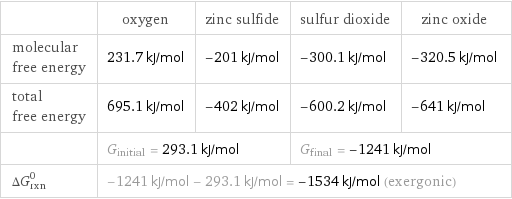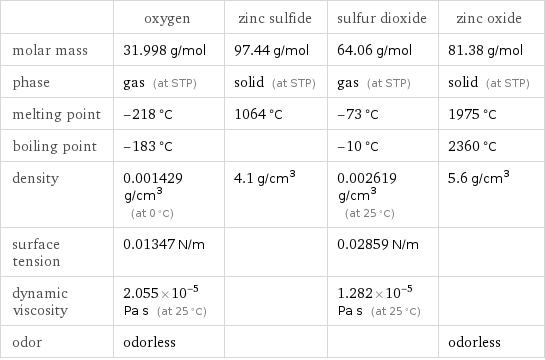Input interpretation

O_2 (oxygen) + ZnS (zinc sulfide) ⟶ SO_2 (sulfur dioxide) + ZnO (zinc oxide)
Balanced equation

Balance the chemical equation algebraically: O_2 + ZnS ⟶ SO_2 + ZnO Add stoichiometric coefficients, c_i, to the reactants and products: c_1 O_2 + c_2 ZnS ⟶ c_3 SO_2 + c_4 ZnO Set the number of atoms in the reactants equal to the number of atoms in the products for O, S and Zn: O: | 2 c_1 = 2 c_3 + c_4 S: | c_2 = c_3 Zn: | c_2 = c_4 Since the coefficients are relative quantities and underdetermined, choose a coefficient to set arbitrarily. To keep the coefficients small, the arbitrary value is ordinarily one. For instance, set c_2 = 1 and solve the system of equations for the remaining coefficients: c_1 = 3/2 c_2 = 1 c_3 = 1 c_4 = 1 Multiply by the least common denominator, 2, to eliminate fractional coefficients: c_1 = 3 c_2 = 2 c_3 = 2 c_4 = 2 Substitute the coefficients into the chemical reaction to obtain the balanced equation: Answer: | | 3 O_2 + 2 ZnS ⟶ 2 SO_2 + 2 ZnO
Structures

+ ⟶ +
Names

oxygen + zinc sulfide ⟶ sulfur dioxide + zinc oxide
Reaction thermodynamics
Enthalpy

| oxygen | zinc sulfide | sulfur dioxide | zinc oxide molecular enthalpy | 0 kJ/mol | -206 kJ/mol | -296.8 kJ/mol | -350.5 kJ/mol total enthalpy | 0 kJ/mol | -412 kJ/mol | -593.6 kJ/mol | -701 kJ/mol | H_initial = -412 kJ/mol | | H_final = -1295 kJ/mol | ΔH_rxn^0 | -1295 kJ/mol - -412 kJ/mol = -882.6 kJ/mol (exothermic) | | |
Gibbs free energy

| oxygen | zinc sulfide | sulfur dioxide | zinc oxide molecular free energy | 231.7 kJ/mol | -201 kJ/mol | -300.1 kJ/mol | -320.5 kJ/mol total free energy | 695.1 kJ/mol | -402 kJ/mol | -600.2 kJ/mol | -641 kJ/mol | G_initial = 293.1 kJ/mol | | G_final = -1241 kJ/mol | ΔG_rxn^0 | -1241 kJ/mol - 293.1 kJ/mol = -1534 kJ/mol (exergonic) | | |
Entropy

| oxygen | zinc sulfide | sulfur dioxide | zinc oxide molecular entropy | 205 J/(mol K) | 58 J/(mol K) | 248 J/(mol K) | 44 J/(mol K) total entropy | 615 J/(mol K) | 116 J/(mol K) | 496 J/(mol K) | 88 J/(mol K) | S_initial = 731 J/(mol K) | | S_final = 584 J/(mol K) | ΔS_rxn^0 | 584 J/(mol K) - 731 J/(mol K) = -147 J/(mol K) (exoentropic) | | |
Equilibrium constant
![Construct the equilibrium constant, K, expression for: O_2 + ZnS ⟶ SO_2 + ZnO Plan: • Balance the chemical equation. • Determine the stoichiometric numbers. • Assemble the activity expression for each chemical species. • Use the activity expressions to build the equilibrium constant expression. Write the balanced chemical equation: 3 O_2 + 2 ZnS ⟶ 2 SO_2 + 2 ZnO Assign stoichiometric numbers, ν_i, using the stoichiometric coefficients, c_i, from the balanced chemical equation in the following manner: ν_i = -c_i for reactants and ν_i = c_i for products: chemical species | c_i | ν_i O_2 | 3 | -3 ZnS | 2 | -2 SO_2 | 2 | 2 ZnO | 2 | 2 Assemble the activity expressions accounting for the state of matter and ν_i: chemical species | c_i | ν_i | activity expression O_2 | 3 | -3 | ([O2])^(-3) ZnS | 2 | -2 | ([ZnS])^(-2) SO_2 | 2 | 2 | ([SO2])^2 ZnO | 2 | 2 | ([ZnO])^2 The equilibrium constant symbol in the concentration basis is: K_c Mulitply the activity expressions to arrive at the K_c expression: Answer: | | K_c = ([O2])^(-3) ([ZnS])^(-2) ([SO2])^2 ([ZnO])^2 = (([SO2])^2 ([ZnO])^2)/(([O2])^3 ([ZnS])^2)](../image_source/3fdc59f937c0b31841958f39627cc7f3.png)
Construct the equilibrium constant, K, expression for: O_2 + ZnS ⟶ SO_2 + ZnO Plan: • Balance the chemical equation. • Determine the stoichiometric numbers. • Assemble the activity expression for each chemical species. • Use the activity expressions to build the equilibrium constant expression. Write the balanced chemical equation: 3 O_2 + 2 ZnS ⟶ 2 SO_2 + 2 ZnO Assign stoichiometric numbers, ν_i, using the stoichiometric coefficients, c_i, from the balanced chemical equation in the following manner: ν_i = -c_i for reactants and ν_i = c_i for products: chemical species | c_i | ν_i O_2 | 3 | -3 ZnS | 2 | -2 SO_2 | 2 | 2 ZnO | 2 | 2 Assemble the activity expressions accounting for the state of matter and ν_i: chemical species | c_i | ν_i | activity expression O_2 | 3 | -3 | ([O2])^(-3) ZnS | 2 | -2 | ([ZnS])^(-2) SO_2 | 2 | 2 | ([SO2])^2 ZnO | 2 | 2 | ([ZnO])^2 The equilibrium constant symbol in the concentration basis is: K_c Mulitply the activity expressions to arrive at the K_c expression: Answer: | | K_c = ([O2])^(-3) ([ZnS])^(-2) ([SO2])^2 ([ZnO])^2 = (([SO2])^2 ([ZnO])^2)/(([O2])^3 ([ZnS])^2)
Rate of reaction
![Construct the rate of reaction expression for: O_2 + ZnS ⟶ SO_2 + ZnO Plan: • Balance the chemical equation. • Determine the stoichiometric numbers. • Assemble the rate term for each chemical species. • Write the rate of reaction expression. Write the balanced chemical equation: 3 O_2 + 2 ZnS ⟶ 2 SO_2 + 2 ZnO Assign stoichiometric numbers, ν_i, using the stoichiometric coefficients, c_i, from the balanced chemical equation in the following manner: ν_i = -c_i for reactants and ν_i = c_i for products: chemical species | c_i | ν_i O_2 | 3 | -3 ZnS | 2 | -2 SO_2 | 2 | 2 ZnO | 2 | 2 The rate term for each chemical species, B_i, is 1/ν_i(Δ[B_i])/(Δt) where [B_i] is the amount concentration and t is time: chemical species | c_i | ν_i | rate term O_2 | 3 | -3 | -1/3 (Δ[O2])/(Δt) ZnS | 2 | -2 | -1/2 (Δ[ZnS])/(Δt) SO_2 | 2 | 2 | 1/2 (Δ[SO2])/(Δt) ZnO | 2 | 2 | 1/2 (Δ[ZnO])/(Δt) (for infinitesimal rate of change, replace Δ with d) Set the rate terms equal to each other to arrive at the rate expression: Answer: | | rate = -1/3 (Δ[O2])/(Δt) = -1/2 (Δ[ZnS])/(Δt) = 1/2 (Δ[SO2])/(Δt) = 1/2 (Δ[ZnO])/(Δt) (assuming constant volume and no accumulation of intermediates or side products)](../image_source/e537adcaba79addd80758737897f9958.png)
Construct the rate of reaction expression for: O_2 + ZnS ⟶ SO_2 + ZnO Plan: • Balance the chemical equation. • Determine the stoichiometric numbers. • Assemble the rate term for each chemical species. • Write the rate of reaction expression. Write the balanced chemical equation: 3 O_2 + 2 ZnS ⟶ 2 SO_2 + 2 ZnO Assign stoichiometric numbers, ν_i, using the stoichiometric coefficients, c_i, from the balanced chemical equation in the following manner: ν_i = -c_i for reactants and ν_i = c_i for products: chemical species | c_i | ν_i O_2 | 3 | -3 ZnS | 2 | -2 SO_2 | 2 | 2 ZnO | 2 | 2 The rate term for each chemical species, B_i, is 1/ν_i(Δ[B_i])/(Δt) where [B_i] is the amount concentration and t is time: chemical species | c_i | ν_i | rate term O_2 | 3 | -3 | -1/3 (Δ[O2])/(Δt) ZnS | 2 | -2 | -1/2 (Δ[ZnS])/(Δt) SO_2 | 2 | 2 | 1/2 (Δ[SO2])/(Δt) ZnO | 2 | 2 | 1/2 (Δ[ZnO])/(Δt) (for infinitesimal rate of change, replace Δ with d) Set the rate terms equal to each other to arrive at the rate expression: Answer: | | rate = -1/3 (Δ[O2])/(Δt) = -1/2 (Δ[ZnS])/(Δt) = 1/2 (Δ[SO2])/(Δt) = 1/2 (Δ[ZnO])/(Δt) (assuming constant volume and no accumulation of intermediates or side products)
Chemical names and formulas

| oxygen | zinc sulfide | sulfur dioxide | zinc oxide formula | O_2 | ZnS | SO_2 | ZnO Hill formula | O_2 | SZn | O_2S | OZn name | oxygen | zinc sulfide | sulfur dioxide | zinc oxide IUPAC name | molecular oxygen | thioxozinc | sulfur dioxide | oxozinc
Substance properties

| oxygen | zinc sulfide | sulfur dioxide | zinc oxide molar mass | 31.998 g/mol | 97.44 g/mol | 64.06 g/mol | 81.38 g/mol phase | gas (at STP) | solid (at STP) | gas (at STP) | solid (at STP) melting point | -218 °C | 1064 °C | -73 °C | 1975 °C boiling point | -183 °C | | -10 °C | 2360 °C density | 0.001429 g/cm^3 (at 0 °C) | 4.1 g/cm^3 | 0.002619 g/cm^3 (at 25 °C) | 5.6 g/cm^3 surface tension | 0.01347 N/m | | 0.02859 N/m | dynamic viscosity | 2.055×10^-5 Pa s (at 25 °C) | | 1.282×10^-5 Pa s (at 25 °C) | odor | odorless | | | odorless
Units
